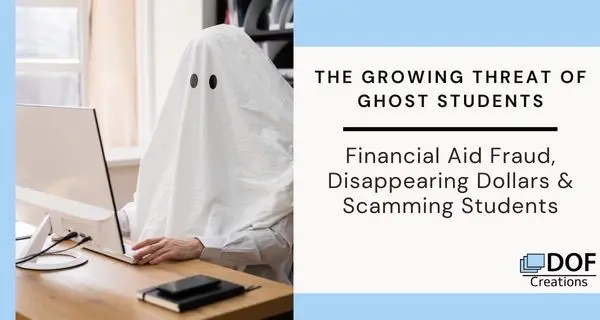As colleges increasingly embrace online and hybrid learning models, they face an emerging and serious threat: ghost students. These fraudulent individuals or fake identities exploit the education system by enrolling in online courses and often receiving federal financial aid, such as Pell Grants, which are intended for legitimate students. Ghost students pose a significant challenge, draining financial resources, disrupting enrollment processes, and exposing institutions to major cybersecurity risks.
This blog explores how ghost students operate, their impact on college resources, and the critical need for institutions to enhance both their identity verification processes and cybersecurity measures.
What Are Ghost Students?
Ghost students are fake identities created by scammers to exploit college enrollment systems. They often target online and community colleges, where the application process may lack stringent identification measures, like Social Security numbers, making it easier to slip through. Once enrolled, these ghost students apply for federal financial aid, defrauding institutions and displacing genuine students.
How Ghost Students Harm Colleges
- Financial Losses: Ghost students steal significant amounts of federal financial aid. A notable example is in California, where approximately 460,000 out of 2.3 million applications between 2022 and 2023 were deemed fraudulent. In one case, three individuals were charged with obtaining nearly $1 million in federal loans by enrolling fake students. These scams not only deprive real students of financial support but also undermine the integrity of financial aid programs.
- Disruption to Class Enrollment: Fraudulent enrollments cause unnecessary demand, leading colleges to open more courses and allocate resources accordingly. When ghost students are purged, these courses remain underpopulated, wasting valuable resources. For instance, at Pierce College in California, nearly 36% of student accounts were found to be fraudulent, contributing to a significant enrollment drop once those accounts were removed.
- Increased Administrative Burden: Ghost students force colleges to dedicate extra resources to fraud detection and enrollment verification. Admissions staff, IT departments, and financial aid offices must spend time scrutinizing applications, managing the fallout from fraudulent enrollments, and trying to recover lost funds.
Ghost Students as a Cybersecurity Threat
Beyond financial fraud, ghost students pose serious cybersecurity threats, often gaining unauthorized access to sensitive systems once enrolled. Here’s how ghost students can undermine a college’s cybersecurity defenses:
- Unauthorized Access to Systems: After enrolling, ghost students are granted access to institutional networks, email systems, and cloud services, intended only for legitimate users. This access gives fraudsters the ability to steal sensitive data, spread malware, and even launch phishing attacks against other students or faculty members.
- Weakening of Security Protocols: Colleges, especially those with lax identity verification procedures, can be easy targets for cybercriminals. Once inside, ghost students exploit vulnerabilities within the network, potentially leaving the institution open to further attacks.
- Expanding Attack Surfaces: Every fraudulent account increases an institution’s exposure to cyber threats, providing new entry points for cybercriminals. This expanded attack surface allows fraudsters to move laterally across systems, escalating their privileges and gaining access to confidential data like student records and research.
- Ransomware and External Scams: Ghost students may facilitate ransomware attacks or use their student credentials to launch scams from within the institution’s network. These incidents not only tarnish the institution’s reputation but also place its data at risk.
Conclusion: Strengthening Cybersecurity and Identity Verification
Ghost students are a multifaceted threat, impacting financial aid systems, class enrollment, and cybersecurity at colleges. Institutions must prioritize enhanced identity verification procedures to detect fraudulent students before they enroll. Additionally, colleges need to fortify their cybersecurity defenses to prevent unauthorized access, protect sensitive data, and respond quickly to emerging threats. Addressing the ghost student issue will not only safeguard financial resources but also protect the integrity and security of higher education systems.
By taking proactive measures, colleges can stay ahead of fraudsters and ensure their resources benefit the students who truly need them.



